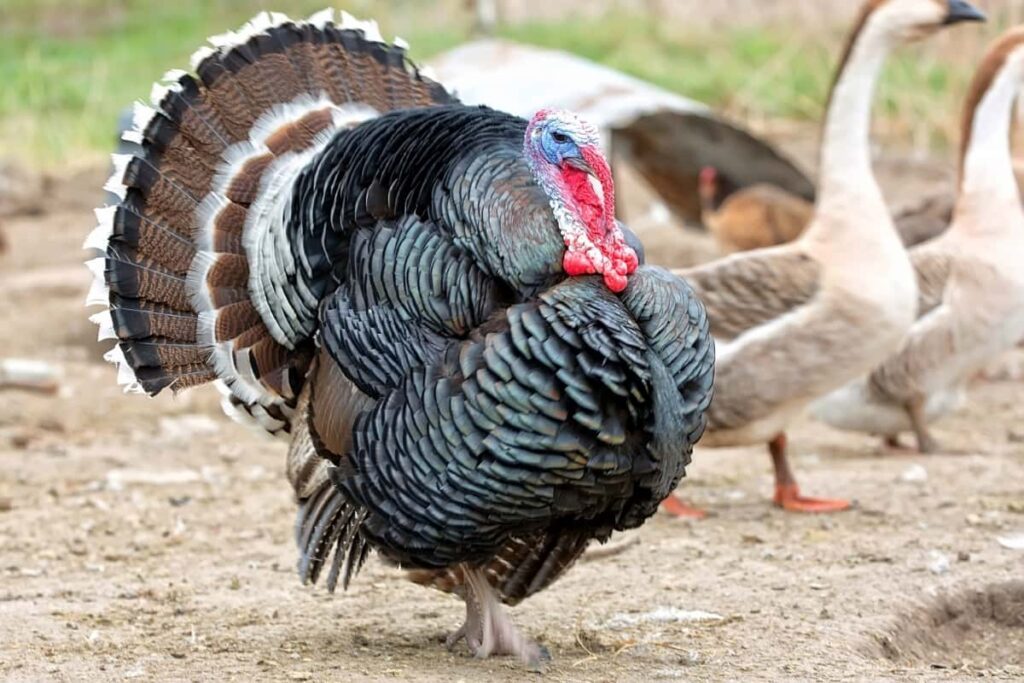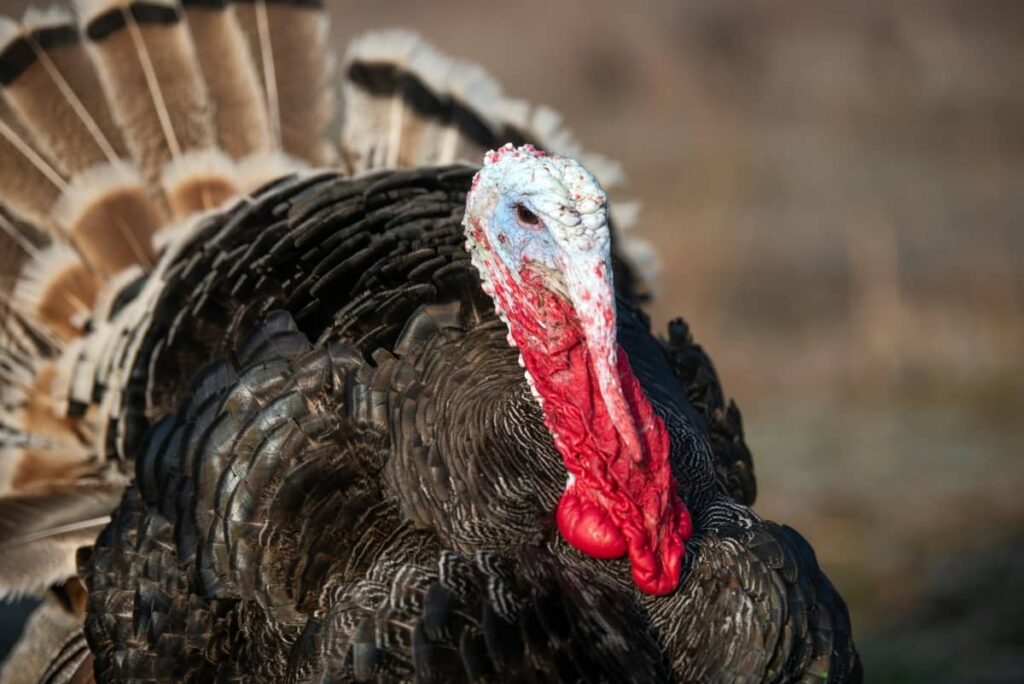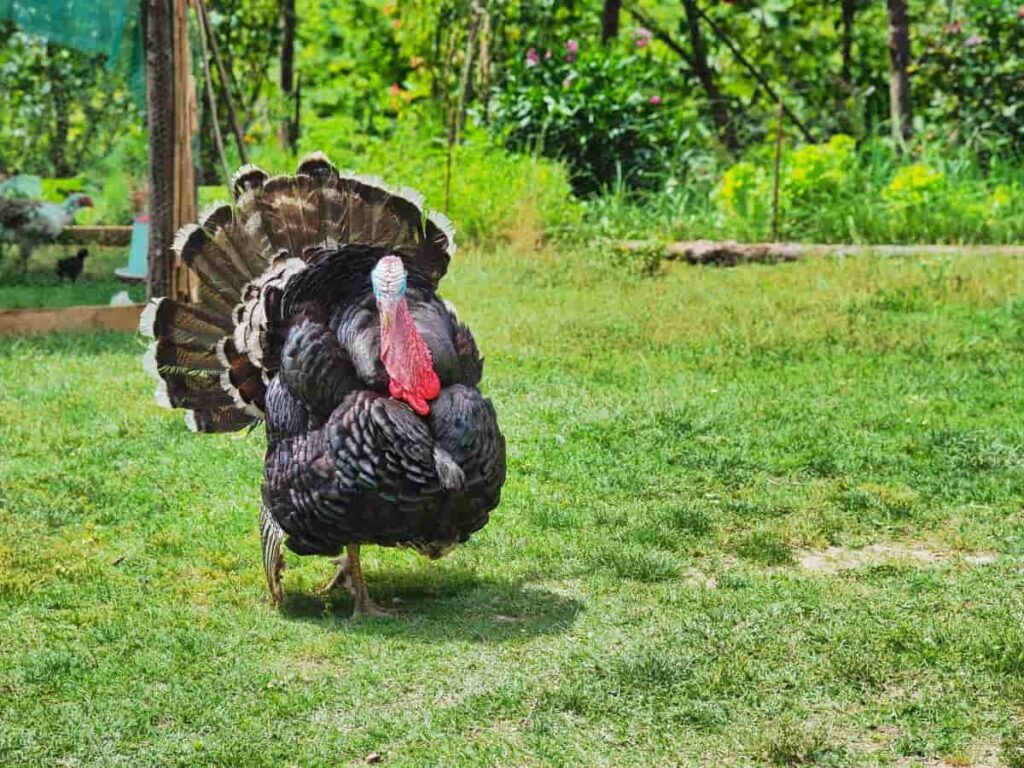The Narragansett Turkey, a fascinating breed of Meleagris gallopavo, is the result of an intriguing cross between the eastern wild Turkey (Meleagris gallopavo silvestris) and the domestic Turkey. This unique lineage gives Narragansett Turkey its distinct characteristics and qualities that make it a prized breed among poultry enthusiasts.

All You Need to Know About Narragansett Turkey Breed
Characteristics
The main characteristic of Narragansett Turkeys is their beautiful plumage, which consists of black, gray, tan, and white feathers. This color pattern sets them apart from other Turkey breeds and adds to their overall aesthetic appeal. In terms of size and weight, hens typically weigh around 14 pounds, while toms can reach up to 23 pounds. These birds have a medium build compared to some other larger Turkey breeds but are still substantial in size.
Temperament-wise, Narragansetts are known for being active birds. They enjoy roaming free-range environments and exploring their surroundings. Their lively nature adds a sense of liveliness to any flock or farm setting. The Narragansett Turkey breed holds historical significance within the country’s agricultural heritage. These characteristics contribute to making Narragansett Turkey an appealing choice for those looking to raise Turkeys both for meat production and as eye-catching additions to their farm or backyard flock.
Narragansett Turkey Profile
| Breed Name | Narragansett Turkey |
| Country of origin | New England |
| Skin color | Black, gray, tan, and white feathers |
| Egg color | Pale cream to medium brown, with spotting |
| Egg size | Large, ideally 2.5–2.8 oz. (70–80 g) |
| Weight | Hen – 14 lbs, Tom – 23 lbs |
| Purpose and Type | Egg Laying and Meat; Exhibition |
| Temperament | Active |
Temperament
Known for its docile and friendly nature, the Narragansett Turkey is a pleasure to have around. These Turkeys are known to be calm and non-aggressive, making them great companions for both adults and children alike. They are friendly birds that enjoy interacting with their owners and other animals on the farm.
They can become quite tame, allowing you to work with them without any issues easily. These birds are not only easy to handle but also adapt well to different environments. Whether you have a large free-range setup or a smaller backyard space, these Turkeys will thrive and adjust accordingly.
Origin and History
The Narragansett Turkey has a fascinating origin story that is deeply rooted in the United States. The name “Narragansett” comes from a Native American tribe that played an important role in the early history of New England. The breeding of Narragansett Turkeys began in Rhode Island during the 18th century, where they were selectively bred for their desirable traits, such as excellent meat quality and attractive feather patterns.
Narragansetts became a staple breed among Turkey enthusiasts across the country. Today, many small-scale farmers continue to raise Narragansett Turkeys for both their delicious meat and their aesthetic appeal. They are valued not only for their high-quality flavor but also for being self-sufficient birds that can thrive in sustainable, free-range systems and family farms.
Size and Weight
The hen typically weighs around 14 pounds, while the tom can reach up to 23 pounds. These measurements make them a substantial breed of Turkey, perfect for those looking for a bird with ample meat production. The size and weight of the Narragansett Turkey also contribute to their impressive presence.
In case you missed it: Turkey Farming Information For Beginners

With its flavorful and tender flesh, the Narragansett Turkey is prized by chefs and food enthusiasts alike. Its generous weight ensures that there will be plenty of succulent meat for family gatherings or holiday feasts. Knowing the average sizes of hens and toms can help in selecting compatible mates for reproduction. Breeders often look at these characteristics as indicators of overall health and vigor in potential offspring.
Uses
The primary use of the Narragansett Turkey is for meat production. The Narragansett Turkey yields good-quality, flavorsome meat that is highly sought after by those who appreciate self-sufficient birds in sustainable, free-range systems and family farms. In addition to being raised for their delectable meat, Narragansett Turkeys are also utilized for exhibition purposes. With their striking black, gray, tan, and white feathers and unique color patterns, they make an eye-catching display at poultry shows and exhibitions.
Furthermore, the Narragansett Turkey can be kept for egg production. Although they do not lay as many eggs as chickens do, they still contribute to the overall egg supply on a farm. Their eggs range from pale cream to medium brown with spotting and are considered large. These Turkeys can add a touch of elegance to any backyard or rural landscape.
Price Range
These beautiful birds are known for their unique coloration and delicious meat, making them a popular choice among Turkey enthusiasts. The price of a Narragansett Turkey can vary depending on several factors like size and weight. On average, these Turkeys have a minimum weight of 16 lbs., which contributes to their hefty price tag. At our farm, we offer Narragansett Turkeys at a competitive price of $250.
Lifespan
These majestic birds have a relatively long lifespan, living on average between 7 to 10 years. This means that if you decide to raise them, you will be in for a long-term commitment. Throughout their lifespan, Narragansett Turkeys bring joy and fulfillment to those who care for them. They become cherished members of the flock and develop unique personalities that make them truly special.
Care and Management
These beautiful birds thrive in spacious areas where they can roam freely. A well-fenced pasture or yard is essential to keep them safe from predators. A balanced and nutritious feed is crucial for their growth and overall health. They should have access to fresh water at all times. Additionally, supplementing their diet with greens and insects can provide additional nutrients.
Regular health check-ups are necessary to ensure that your Narragansett Turkeys remain in good condition. Vaccinations against common poultry diseases should be administered according to recommended schedules. It’s important to monitor the behavior and activity level of your Turkeys daily. Any signs of illness or distress should be addressed promptly by consulting a veterinarian who specializes in poultry care.
Narragansett Turkey Egg Production
Narragansett Turkeys, in particular, can lay between 50-100 eggs during a season. While this may not seem like much compared to chickens’ prolific laying abilities, it’s important to remember that Narragansetts are primarily raised for their flavorful meat. The eggs themselves are pale cream to medium brown and often have spotting on them, adding a touch of uniqueness. With an ideal size of 2.5-2.8 ounces (70-80 grams), these large eggs pack quite a punch.
Breeding and Reproduction
These beautiful birds have unique breeding patterns that make them fascinating to observe. When it comes to reproduction, Narragansett Turkey is known for its natural mating abilities. Breeding season typically occurs in spring. The male turkeys, also known as toms, display their vibrant plumage to attract the attention of the hens.
Once a pair forms a bond, mating takes place naturally. Breeders need to provide suitable nesting areas where hens can lay their eggs undisturbed. After mating has occurred, female Turkeys will seek out secluded spots such as bushes or tall grasses to create nests from leaves and twigs.
The incubation period for Narragansett Turkey eggs is approximately 28 days. During this time, breeders must ensure proper temperature and humidity levels for successful embryo development. As with any breeding program, it’s essential to maintain genetic diversity within Narragansett Turkey flocks. Breeders should carefully select tom and hen pairs based on desired traits such as size, coloration, and temperament.
Frequently Asked Questions (FAQ) on Narragansett Turkeys
How to Do Narragansett Turkeys Look Like?
The most striking feature of Narragansett Turkey is its beautiful plumage. They have black feathers with bands of metallic gray or bronze on their bodies and tail feathers, creating an eye-catching pattern. Their heads are predominantly red, adorned with a bluish-white band across their forehead.
Do Narragansett Turkeys Make Good Pets?
Absolutely! Narragansetts are known for their docile nature and friendly disposition, making them suitable as both farm birds and pets. They can develop strong bonds with humans if given plenty of socialization from an early age.
Do Narragansett Turkeys Require Special Care During Winter Months?
Yes. Turkeys can withstand cold temperatures but need protection from drafts and wet conditions in the winter months. Providing extra bedding material in their coop will help keep them warm.
In case you missed it: Serama Chicken Breed Profile and Characteristics

Conclusion
Raising Narragansett Turkeys promotes sustainability and self-reliance in farming practices. These Turkeys have been bred to thrive in various climates, making them suitable for different regions. Narragansett Turkeys are also renowned for their flavorful meat. Their rich and succulent flesh makes them a popular choice among Turkey enthusiasts and food lovers alike.
Note: The images presented in this post are intended solely for representation purposes. The images are meant to serve as visual aids and should not be relied upon as accurate representations of their real-life counterparts.
- Profitable Village Farming Business Ideas in 2024
- High-Yield Aquaculture: Fast-Growing Fish for Farming
- Effective Fish Pond Construction Techniques for Beginners
- Irrigation and Water Management in Pineapple Farming
- Blossom to Harvest: Mastering Flowering and Pollination in Papaya Farming
- Pig Fattening Essentials: From Selection to Sale for Beginners
- Raising Wagyu Cattle: A Complete Guide for Premium Beef Production
- Soil Types and Their Water Holding Capacity
- Optimizing Irrigation Schedules for Coconut Groves for Enhanced Yield
